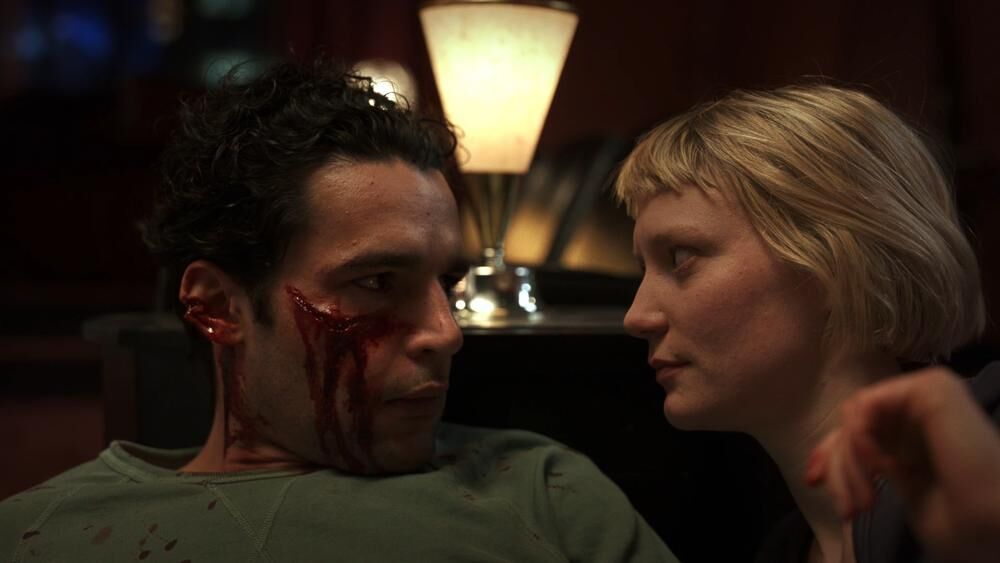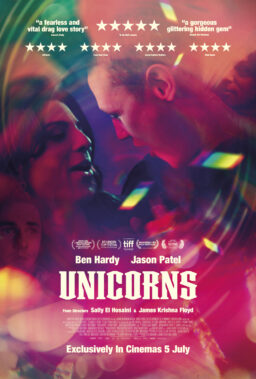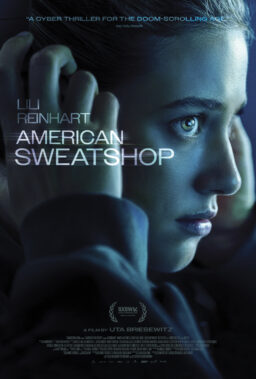Nicolas Pesce calls his work “a soup of influences.” Add a dash of Alfred Hitchcock, a pinch of David Lynch, a splash of Takashi Miike, a sprinkle of Jacques Tati for sweetness; 70 minutes later, “Piercing,” Pesce’s follow up to his 2016 debut, “The Eyes of My Mother,” brims over with vivid madness.
“Piercing” is violent on the edge of nauseating, a naughty, kinky pleasure for gauging fortitude. It’s also hyper-stylized, and that stylization puts Pesce’s influences in the background while he foregrounds the film in one particular style, giallo, that Italian thriller-horror sub-genre, fittingly a soup unto itself. Giallo comprises whodunits and slashers fueled by sex, psychology, and exploitation, but “Piercing”s primary source isn’t Italian; rather, it’s the unsettling 1994 novel of the same name by Ryū Murakami.
Murakami’s book takes place in Tokyo and orbits a man with an awful need to impale his newborn baby with an icepick; he resolves to handle his problem by taking out his murderous needs on a prostitute, but as anyone who reads these kinds of stories can guess, the prostitute turns the tables on him. Pesce’s film leaves the pieces of Murakami’s work intact, casting Christopher Abbott as Reid, the man, and Mia Wasikowska as Jackie, his target. But “Piercing” transplants the material from Tokyo to Anywhere, USA, maybe New York City, maybe Chicago, certainly not Japan. That’d miss the point of the exercise.

“I didn’t want to make something that felt like, you know, a J-horror movie or a pink movie,” Pesce says. “I wanted to do it in my own way.” That means beginning with Murakami, as well as the book’s fascination with Paul Verhoeven’s “Basic Instinct,” and letting his other inspirations take over from there. Simply putting the book on screen, exact to a fault, has no value for him. “The book exists,” he explains, “and if you love that, that will always exist. I can’t make the perfect version of that.” So Pesce pivoted by turning to Dario Argento, Mario Bava, Massimo Dallamano, and Luciano Ercoli.
Gender dynamics and sex politics, rooted in the psychosexual, are defining features of giallo. Pesce uses them to bolster “Piercing”s structure, starting with its visuals. “I felt like this was a Japanese cousin to the giallo movie,” Pesce professes. “Tokyo in my head is so colorful and bright and loud and vibrant. My version of that fell in nicely in a lot of the stylistic choices that giallo filmmakers made.” Magenta hues bathe the opening scene as Reed contemplates infanticide; Jackie’s lipstick runs as red as her flat’s walls. There are the wardrobes, too, Reed’s sharp suits and impeccable hair, Jackie’s blonde bob, slick black dresses, and the fur coat she warehouses herself in—bright colors that mirror the keystones of the giallo aesthetic.
But more integral to giallo than fashion and furniture is sex. “When I read the book, it was very much like Murakami doing a take on the ‘Basic Instinct’ style thriller,” he says, “the Western sort of psychosexual thriller, but transposing it into his world and Tokyo and that underbelly.” To get from there to giallo, he followed his instincts and mined giallo out of Reed’s clash with Jackie. If atmosphere isn’t a hint that not all’s right with Jackie, then watching her take off her black gloves as Reed pours her a drink should serve as the tip-off. “In every giallo movie, whoever wears the black gloves is the killer and the adversary,” Pesce says with a chuckle. The viewer meets the heavy immediately, and they may not even know it.

Partly that’s because Abbott plays such a convincing psychopath, but Wasikowska, no stranger to characters burdened by psychological hang-ups (see: “Stoker” and “Maps to the Stars”), is as unassuming as Abbott is menacing. The gloves are a subtle nod to giallo tradition, but Pesce happily plays with genre conventions as he hews to them. “Piercing” turns the tables on Reed, the presumed murderer-to-be, putting ownership of those gender dynamics and sex politics in Jackie’s hands. She’s in control, unlike most women in giallo, who often find themselves stalked and killed by men: “Tenebrae,” “Blood and Black Lace,” “What Have You Done to Solange?,” “Your Vice Is a Locked Room and Only I Have the Key.” It’s a thing. (So are inordinately long titles.)
Sometimes women just get stalked, as in Ercholi’s “Forbidden Photos of a Lady Above Suspicion,” but the politics of control remain the same. Not so with “Piercing.” “The beauty of the story in and of itself is that it flips all the expectations on their heads,” Pesce says. “A movie like this is set up to be, like, you meet this guy who wants to kill a prostitute, he hires a prostitute and he kills her.” But “Piercing” lets Jackie be the predator and Reed the prey, adding complexity to the tension between consent and desire that’s so essential to giallo’s spirit. “It’s a movie about murder with no murder,” he laughs. For giallo purists, that might sound like a birthday party without a cake. Not that giallo formula’s never been subverted—a la Bava’s “Hatchet for the Honeymoon,” or Argento’s “Tenebrae”—but it’s uncommon practice. So the role swap makes “Piercing” unique, even empowering.
“In decades’ worth of these types of movies,” Pesce muses, “you set up a girl in the beginning of the movie who’s set to be a victim and the whole movie is about proving that your male lead is the hero who’s going to save her. And nah, this girl doesn’t need anyone to save her. She doesn’t need any help. She’s got it all covered.” So does Pesce, hitting the giallo bases and Murakami’s book while coaxing his movie toward an identity all its own. Call “Piercing” a soup, a chowder, a mélange; Pesce’s film embraces genre history while facing forward, gruesome and tender in almost equal measure.











